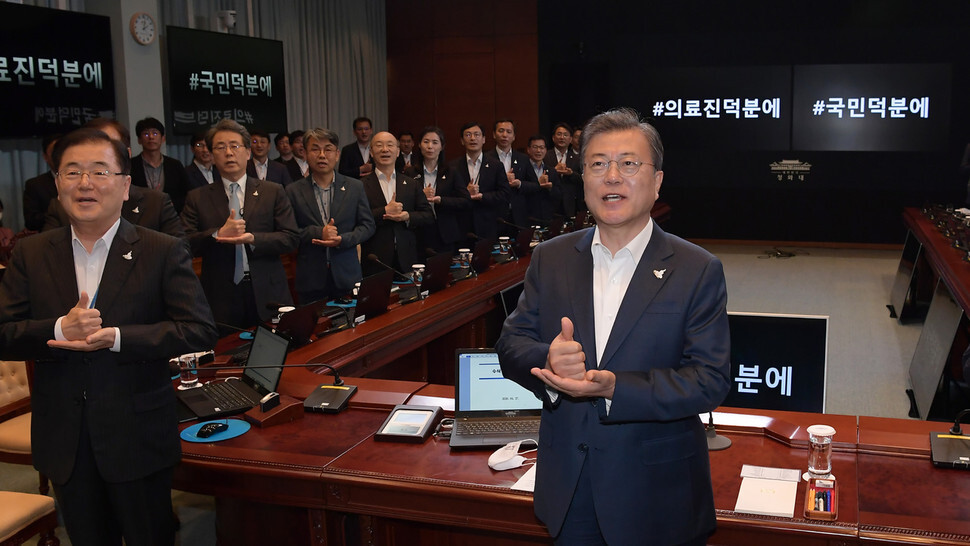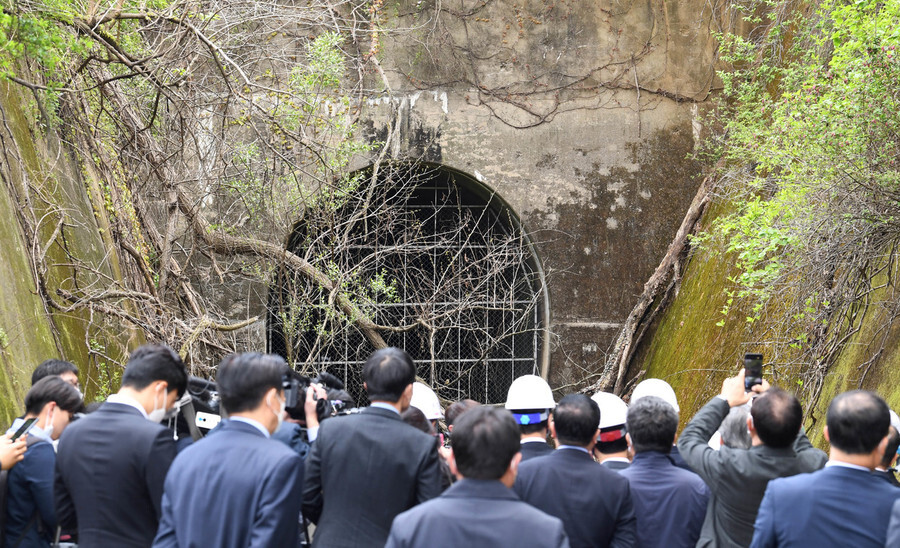hankyoreh
Links to other country sites 다른 나라 사이트 링크
Moon says COVID-19 is opportunity for two Koreas to come together

On Apr. 27, South Korean President Moon Jae-in said that South and North Korea form “a single community of life” and that working together to combat the COVID-19 crisis is “the most urgent and critical challenge for cooperation right now.”
“The coronavirus crisis could serve as a new opportunity for inter-Korean cooperation. I hope that inter-Korean exchange and cooperation will start with a joint response to COVID-19 and continue with a joint response to infectious diseases affecting livestock, disasters in the border region, and climate change, on behalf of the vitality of the Korean Peninsula,” Moon said during a meeting of his senior secretaries and aides in the Blue House on Monday. Apr. 27 marked the second anniversary of the Panmunjom Declaration.
“The inter-Korean community of life will serve as the foundation for moving toward a community of peace. We will open the door to the future of the ‘peace economy’ through my relationship of trust with Chairman Kim Jong-un and our firm commitment to peace,” Moon added.
Moon also stressed that the fundamental spirit of the Panmunjom Declaration — namely, solidarity and cooperation — has become even more critical in the age of the coronavirus. “COVID-19 is awakening the spirit of solidarity and cooperation. I look forward to South and North Korea moving more quickly to overcome the outbreak and to implement the Panmunjom Declaration so as to usher in the post-corona world and open the door to a Korean Peninsula of peace, prosperity, and symbiotic development.”
In addition, Moon expressed his regret for sluggish progress in inter-Korean relations since the Panmunjom Declaration. “While the Panmunjom Declaration irreversibly opened the door to peace, the past two years have keenly reminded us that peace doesn’t come all at once. [However,] we can’t just wait for conditions to improve. We must keep working on what practical limitations permit, no matter how small,” Moon underlined.
Along with this, Moon announced plans to turn the demilitarized zone (DMZ) into an international zone of peace, arrange reunions for families divided by the Korean War, and allow those displaced by the war to visit their old homes, after the COVID-19 situation has been stabilized.
But all those plans were presented as Moon’s firm intentions and hopes, rather than calls to action or official proposals for talks with the North Koreans. Moon appears to have moderated his tone in recognition of the long-standing deadlock in inter-Korean relations.

In light of these remarks, a ceremony held on Monday as part of a project to reconnect the northern section of the Donghae (East Sea) Line can be regarded as a first step toward demonstrating Moon’s commitment to “start with things that are small but feasible.” The ceremony was held at Jejin Station, the northernmost train station on the South Korean half of the Donghae Line, which runs along the eastern coastline of the Korean Peninsula.
Jointly hosted by the Unification Ministry and the Ministry of Land, Infrastructure, and Transport, the ceremony officially expresses the government’s desire to accelerate a project to reconnect a 110.9km stretch of the northern section of the Donghae Line between South Gangneung and Jejin, in Gangwon Province.
Minister of Land, Infrastructure, and Transport Kim Hyun-mi pledged that work would go quickly. “Reconnecting the northern section of the Donghae Line is a project that will not only contribute to the country’s balanced development but also help prepare for inter-Korean railroad cooperation. Our plan is to move forward swiftly with this project with the goal of drawing up the basic plan by the end of this year and initiating construction at the end of next year,” she said.
The connection and modernization of inter-Korean roads and railways was one of the key agreements reached in the Panmunjom Declaration and the Pyongyang Declaration (released on Sept. 19, 2018).
By Lee Je-hun, senior staff writer, and Seong Yeon-cheol, staff reporter
Please direct comments or questions to [english@hani.co.kr]

Editorial・opinion
![[Column] Park Geun-hye déjà vu in Yoon Suk-yeol [Column] Park Geun-hye déjà vu in Yoon Suk-yeol](https://flexible.img.hani.co.kr/flexible/normal/500/300/imgdb/original/2024/0424/651713945113788.jpg) [Column] Park Geun-hye déjà vu in Yoon Suk-yeol
[Column] Park Geun-hye déjà vu in Yoon Suk-yeol![[Editorial] New weight of N. Korea’s nuclear threats makes dialogue all the more urgent [Editorial] New weight of N. Korea’s nuclear threats makes dialogue all the more urgent](https://flexible.img.hani.co.kr/flexible/normal/500/300/imgdb/original/2024/0424/7317139454662664.jpg) [Editorial] New weight of N. Korea’s nuclear threats makes dialogue all the more urgent
[Editorial] New weight of N. Korea’s nuclear threats makes dialogue all the more urgent- [Guest essay] The real reason Korea’s new right wants to dub Rhee a founding father
- [Column] ‘Choson’: Is it time we start referring to N. Korea in its own terms?
- [Editorial] Japan’s rewriting of history with Korea has gone too far
- [Column] The president’s questionable capacity for dialogue
- [Column] Are chaebol firms just pizza pies for families to divvy up as they please?
- [Column] Has Korea, too, crossed the Rubicon on China?
- [Correspondent’s column] In Japan’s alliance with US, echoes of its past alliances with UK
- [Editorial] Does Yoon think the Korean public is wrong?
Most viewed articles
- 1‘We must say no’: Seoul defense chief on Korean, USFK involvement in hypothetical Taiwan crisis
- 2N. Korean delegation’s trip to Iran shows how Pyongyang is leveraging ties with Moscow
- 3Amnesty notes ‘erosion’ of freedom of expression in Korea in annual human rights report
- 4‘Weddingflation’ breaks the bank for Korean couples-to-be
- 5[Reportage] On US campuses, student risk arrest as they call for divestment from Israel
- 6[Column] Park Geun-hye déjà vu in Yoon Suk-yeol
- 7Korea sees more deaths than births for 52nd consecutive month in February
- 8Will NewJeans end up collateral damage in internal feud at K-pop juggernaut Hybe?
- 9[Guest essay] The real reason Korea’s new right wants to dub Rhee a founding father
- 10[Editorial] New weight of N. Korea’s nuclear threats makes dialogue all the more urgent